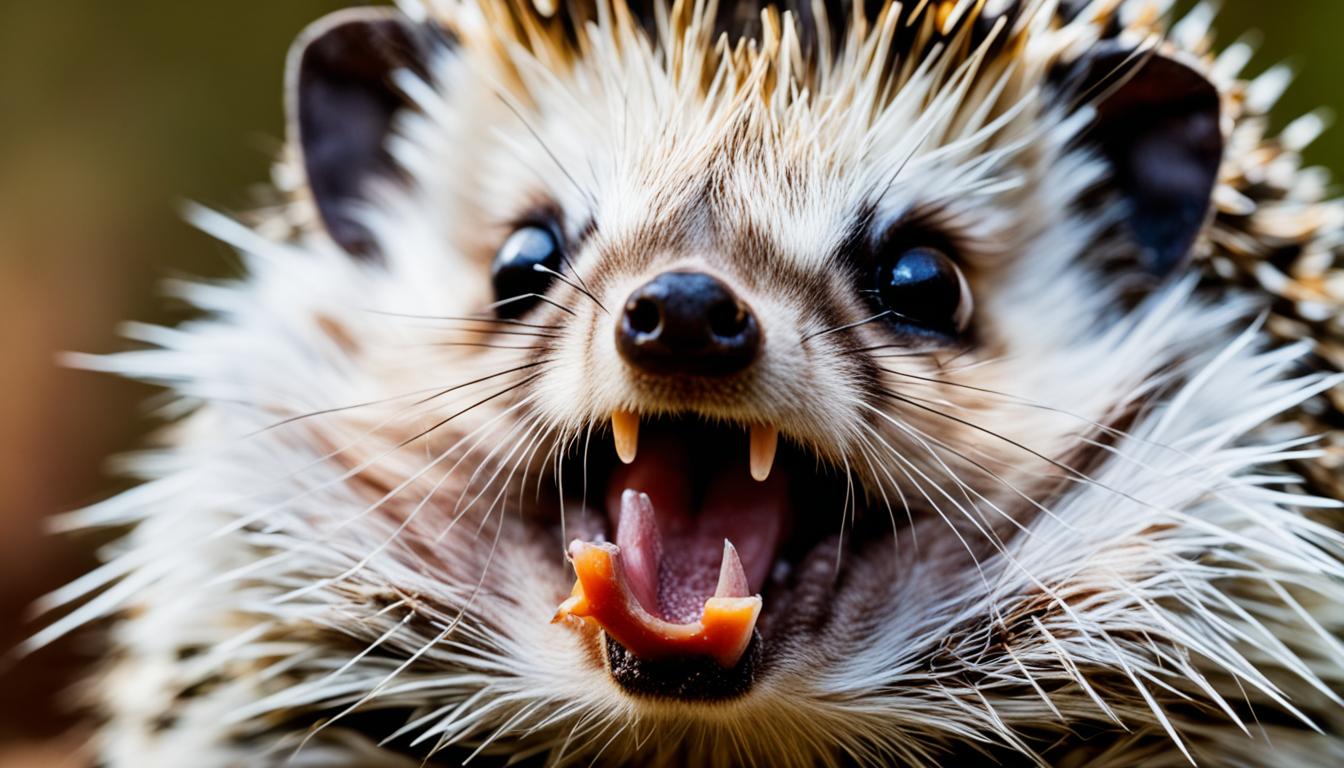Did you realize that there are intriguing marine animals with large lips hiding beneath the ocean’s depths? From colorful reef inhabitants to deep-sea hunters, these fish with large lips are truly a wonder of nature. Their distinct characteristics and actions make them some of the most fascinating creatures in the sea.
Key Takeaways:
- Fish with big lips are captivating marine creatures that are found in various ocean habitats.
- These fish possess unique adaptations and play crucial roles in their ecosystems.
- Some fish with big lips, like the humphead wrasse and the red-lipped batfish, are endangered species that require conservation efforts.
- Exploring the diverse world of fish with big lips allows us to appreciate the incredible biodiversity of our oceans.
- It is important to protect and preserve these ocean wonders for future generations to enjoy.
Humphead Wrasse: The King of the Coral Reef
The humphead wrasse, also known as the king of the coral reef, is one of the largest reef fish in the world. With its distinct lips and a bulbous forehead hump, it is truly a remarkable species. It plays a vital role in its ecosystem by eating hard-shelled invertebrates and helping to maintain the health of coral reefs. Unfortunately, humphead wrasse populations have been declining due to overfishing, habitat loss, and the effects of climate change.
The humphead wrasse (Cheilinus undulatus) is characterized by its large size and vivid coloration, making it a favorite subject for underwater photographers. It can reach lengths of up to 2 meters and weigh over 180 kilograms, making it one of the largest members of the wrasse family. Its lips are thick and protrude outward, giving it a unique appearance that sets it apart from other reef fish.
These majestic creatures are often found in the warm waters of the Indo-Pacific region, particularly around coral reefs. They are known to inhabit areas with rich coral cover, as they rely on corals for both food and shelter. Humphead wrasse have a diverse diet that includes hard-shelled invertebrates like clams, sea urchins, and crabs. Their strong jaws and sharp teeth allow them to crush the shells of their prey, making them an important predator in the coral reef ecosystem.
Despite their ecological importance, humphead wrasse populations have been greatly affected by human activities. Overfishing, driven by high demand in Asian markets for their large lips and tasty flesh, has resulted in severe population declines. Additionally, habitat degradation, including coral bleaching caused by rising ocean temperatures, has further threatened their survival.
“The decline of humphead wrasse populations is deeply concerning. As a key species in coral reef ecosystems, their loss could have far-reaching consequences for the health and biodiversity of these fragile habitats.” – Marine Conservationist
Efforts are underway to protect and conserve humphead wrasse populations. Many countries have implemented fishing regulations and established marine protected areas to safeguard their habitats. Conservation organizations are also working to raise awareness about the importance of these reef fish and encourage sustainable fishing practices.
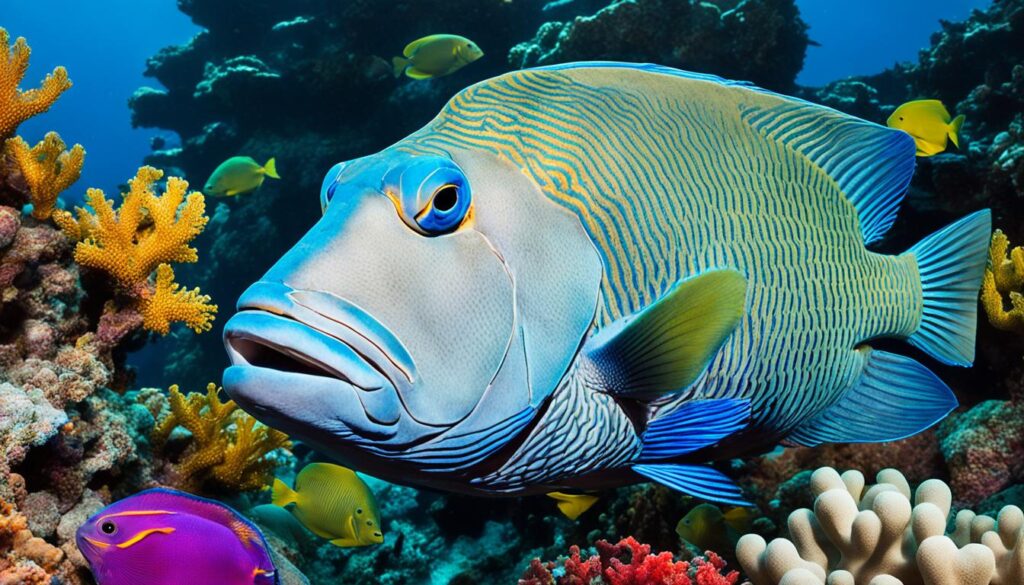
The decline of humphead wrasse populations serves as a stark reminder of the threats faced by reef fish worldwide. It is crucial that we continue to monitor and take action to protect these magnificent creatures and the coral reefs they call home. By preserving their habitat and practicing responsible fishing, we can ensure that the king of the coral reef remains a majestic presence in our oceans for generations to come.
Frilled Shark: An Ancient Deep-Sea Predator
The frilled shark is an ancient deep-sea predator that has managed to survive for millions of years. With its serpentine body and unique gill slits, it is a true marvel of nature. Its elongated body allows it to swiftly move through the water, capturing prey with a sudden lunge. These sharks are found in the deep, dark depths of the ocean, making them a subject of intrigue and study.
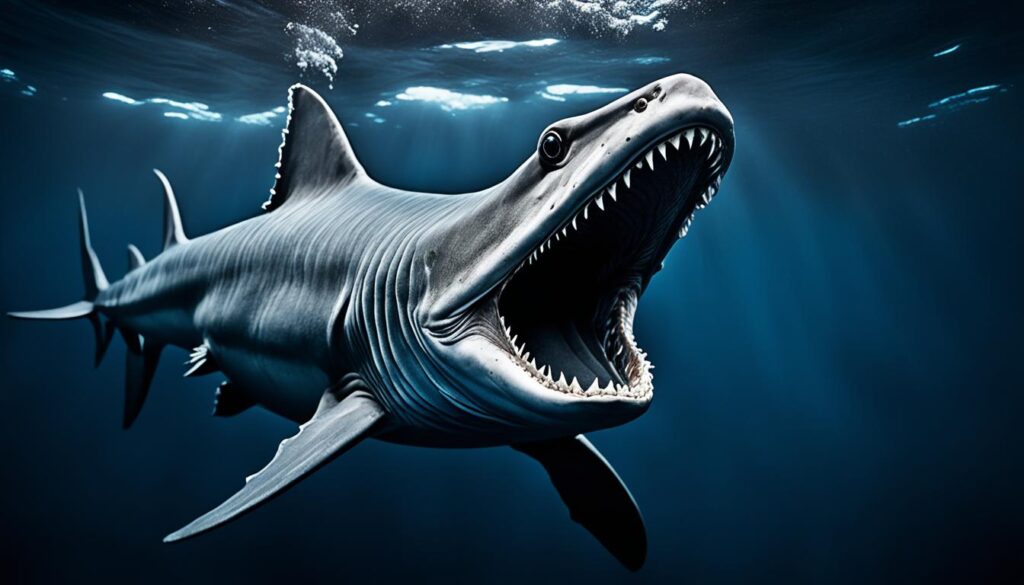
When it comes to deep-sea predators, the frilled shark stands out as a fascinating and ancient species. Its name is derived from the fringed or frill-like appearance of its gills. These gills not only aid in respiration but also contribute to the shark’s unique appearance. The frilled shark’s body is elongated, resembling that of an eel, allowing it to navigate the deep-sea environment with ease. Its elongated body is perfectly adapted for swift movements, enabling it to capture prey efficiently.
The frilled shark’s hunting strategy is characterized by its sudden lunges, using its rows of sharp teeth to snatch its prey. This deep-sea predator primarily feeds on other fish, cephalopods, and even smaller sharks. Its ability to adapt to the extreme conditions of the deep sea is remarkable, highlighting its ancient lineage and evolutionary success.
Scientists have long been captivated by the frilled shark’s anatomy and behavior. Its unique gill structure, reminiscent of ancient fish species, provides invaluable insights into the evolutionary history of these deep-sea predators. Studies and observations of frilled sharks have contributed significantly to our understanding of the ecology and biodiversity of the deep sea.
Red-Lipped Batfish: A Peculiar Galapagos Native
The waters surrounding the Galapagos Islands are home to a truly peculiar fish known as the red-lipped batfish. With its bright red lips and unique body structure, this fish stands out among its counterparts in the underwater realm. It’s a fascinating creature that has captivated marine enthusiasts and scientists alike.
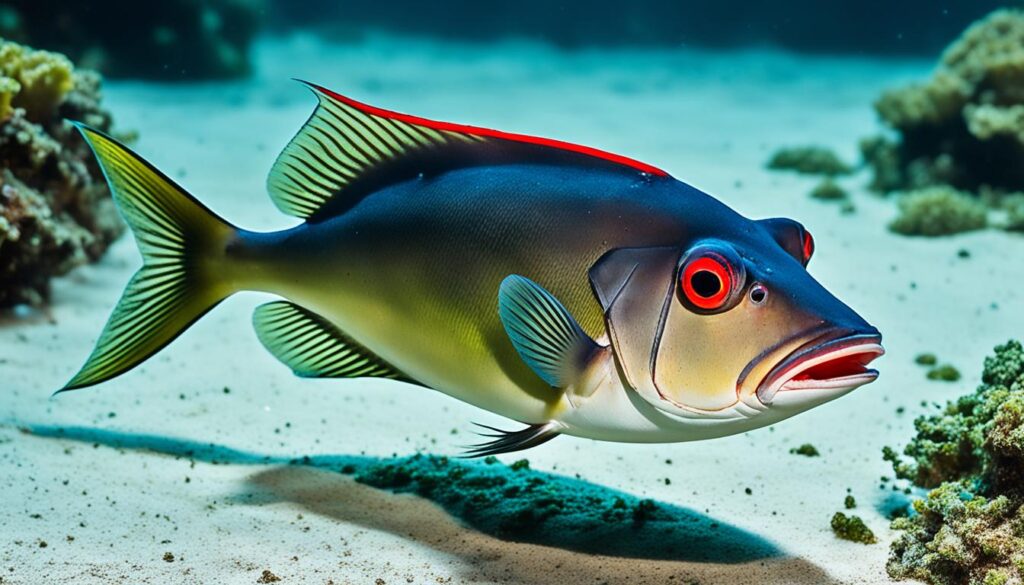
This bottom-dwelling fish has evolved some remarkable adaptations that allow it to thrive in its environment. One of the most notable features of the red-lipped batfish is its ability to “walk” on the ocean floor using its modified pectoral fins. This extraordinary locomotion sets it apart from other fish species.
But the red-lipped batfish doesn’t stop there with its extraordinary abilities. It has also developed a unique hunting technique. The fish uses its dorsal fin, which is modified into a lure, to attract curious prey. Once the unsuspecting prey gets too close, the batfish strikes with lightning speed, making it an excellent ambush predator.
The Galapagos Islands serve as the perfect habitat for the red-lipped batfish. The rich biodiversity and abundance of prey species allow this distinct fish to thrive in these waters. However, like many other marine creatures, the red-lipped batfish also face threats such as habitat destruction and climate change, which could impact its population in the future.
Sunfish: The Gentle Giants of the Ocean
Sunfish, also known as mola mola, are true giants of the ocean. With their flat, round bodies and rough skin, they are often mistaken for large floating discs. These gentle giants can often be seen basking in the sun near the ocean’s surface. They have remarkable reproductive capabilities, with a single female capable of producing millions of eggs at once.
Physical Characteristics of Sunfish
Sunfish have a unique appearance that sets them apart from other marine creatures. Here are some key characteristics:
- Flat, disc-shaped bodies with a height that can reach up to 3 meters (10 feet)
- Rough, thick skin covered in slime to protect them from parasites
- Average weight of 1,000 kilograms (2,200 pounds), making them one of the heaviest bony fish species
Basking in the Sun
One of the most intriguing behaviors of sunfish is their tendency to bask at the ocean’s surface, hence their name. This behavior is believed to serve multiple purposes:
- Regulating body temperature: By basking in the sun, sunfish can warm up their bodies, as their large size makes it challenging for them to retain heat.
- Removing parasites: The sun’s rays help to cleanse the sunfish’s skin of parasites, which are then consumed by birds or cleaner fish.
- Replenishing energy: Sunfish have a slow metabolism and basking allows them to conserve energy by minimizing their movements.
Despite their massive size, sunfish are docile creatures and pose no threat to humans. In fact, they are often curious and approach divers and boats.
The Life Cycle of Sunfish
The life cycle of sunfish is fascinating and involves several stages:
| Stage | Description |
|---|---|
| Egg | A single female sunfish can produce millions of tiny eggs, which are released into the water column. |
| Larva | Once hatched, the larvae are extremely small and undergo a period of rapid growth. |
| Juvenile | The juveniles gradually develop their characteristic disc shape and begin feeding on small prey. |
| Adult | As they mature, sunfish continue to grow in size and reach their full adult form. |
It takes several years for a sunfish to reach adulthood, and their lifespan is estimated to be around 10 years.

These remarkable creatures play an important role in the marine ecosystem. They feed on jellyfish, helping to control populations and maintain balance in the ocean. Despite their massive size and unique appearance, sunfish are vulnerable to threats such as habitat destruction and accidental capture in fishing gear. Conservation efforts are crucial to protect these gentle giants and ensure their long-term survival.
Goblin Shark: A Prehistoric Deep-Sea Predator
When it comes to deep-sea predators, few can rival the striking and enigmatic goblin shark. This prehistoric creature has adapted to the extreme conditions of the abyss, making it a formidable inhabitant of the deep sea.
“The goblin shark’s elongated, flattened snout and sharp teeth are truly a sight to behold,” says marine biologist Dr. Jane Collins.
One of the most remarkable features of the goblin shark is its ability to rapidly extend its jaw, giving it the nickname “the vampire shark.” This unique adaptation allows the goblin shark to capture prey with lightning speed, making it an efficient hunter in the depths.
With its distinct appearance and extraordinary hunting techniques, the goblin shark has become a subject of fascination and study among marine biologists and enthusiasts alike.
The Goblin Shark at a Glance
| Physical Characteristics | Behavior | Habitat |
|---|---|---|
| An elongated and flattened snout | Rapid jaw extension for capturing prey | Deep-sea habitats, typically found between 1,000 and 3,000 meters |
| Sharp, needle-like teeth | Relatively sluggish swimming speed | Cold waters of the Atlantic, Pacific, and Indian Oceans |
| Pale pink to grayish-brown coloration | Ambush predator that waits patiently for prey | Near continental slopes and underwater canyons |
The goblin shark’s unique appearance and hunting techniques have made it a popular subject of documentaries and scientific research. As we continue to explore the mysteries of the deep sea, the goblin shark stands as a testament to the incredible diversity and resilience of marine life.
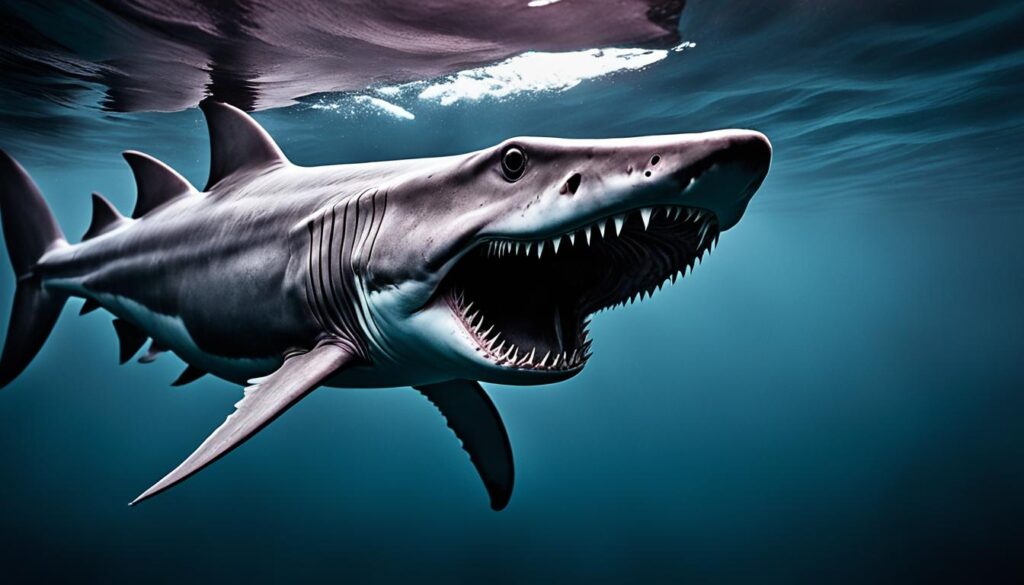
Spotted Handfish: A Rare and Endangered Species
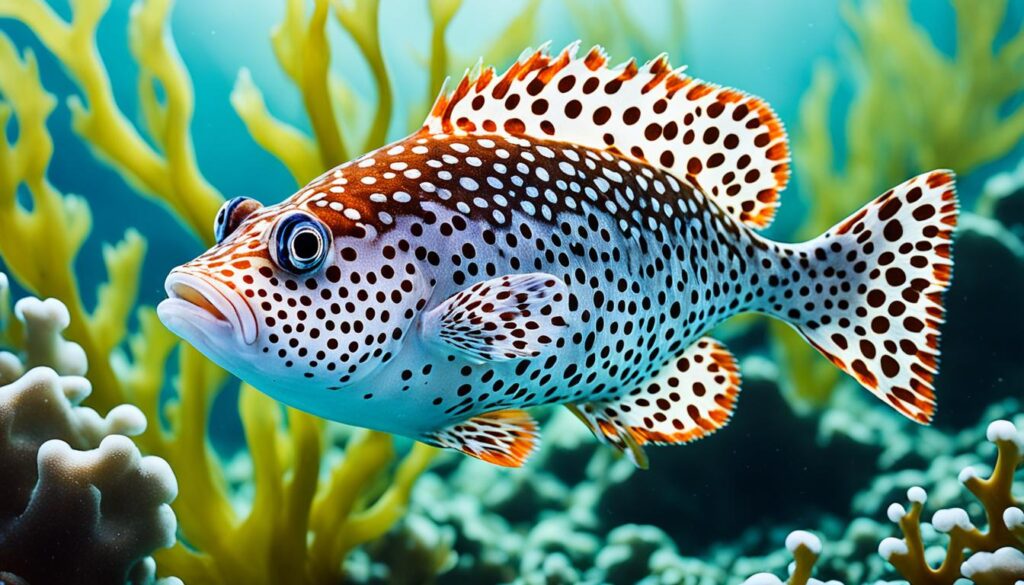
The spotted handfish is a rare and endangered species that can be found in the waters of Australia. With its hand-like fins and distinctive spots, it is truly a unique and captivating fish. This bottom-dwelling fish has adapted to its environment by “walking” along the ocean floor using its modified pectoral fins.
However, the spotted handfish faces numerous threats that have pushed it to the brink of extinction. Its population has been severely affected by habitat loss, pollution, and predation by invasive species such as seastars. As a result, conservation efforts are currently underway to protect and preserve this remarkable species.
We must take immediate action to safeguard the spotted handfish and its habitat. By implementing stricter regulations on fishing practices, promoting marine conservation, and raising awareness about the importance of biodiversity, we can help ensure the survival of this rare and invaluable species.
Threats to the Spotted Handfish
- Predation by invasive seastars
- Habitat loss and degradation
- Pollution
- Climate change effects
“The conservation of the spotted handfish is crucial to preserving the biodiversity of our oceans. Its unique adaptations and delicate ecosystem role make it an important species to protect.” – Marine biologist Dr. Emily Thompson
Through collaborative efforts and community involvement, we can make a difference in the fight to save the spotted handfish from extinction. By supporting initiatives that promote sustainable fishing practices, marine protected areas, and the restoration of critical habitats, we can contribute to the long-term survival of this extraordinary species.
Wolffish: A Cold-Water Predator
The wolffish is a formidable cold-water predator that roams the frigid depths of the Atlantic and Pacific oceans. With its powerful jaws and strong teeth, it is a fearsome hunter, capable of catching and crushing its prey with ease. This unique fish exhibits a range of adaptations that allow it to flourish in the harsh conditions of its environment.
Adaptations for Cold-Water Survival
The wolffish possesses several remarkable adaptations that enable it to thrive in cold waters:
- Antifreeze Protein: One of the most remarkable adaptations of the wolffish is its production of an antifreeze protein in its blood. This protein prevents the fish’s bodily fluids from freezing in the frigid temperatures, allowing it to continue hunting and surviving.
- Sluggish Metabolism: The wolffish’s metabolic rate slows down in cold water, conserving energy and enabling it to survive for extended periods without food. This adaptation helps the fish endure periods of low prey availability.
- Elongated Body: The wolffish’s elongated body allows it to navigate through the water with ease, minimizing resistance and conserving energy. This streamlined physique enables the fish to move swiftly in pursuit of prey.
- Camouflage: To blend in with its icy surroundings, the wolffish displays a mottled coloration that provides effective camouflage. This enables the fish to ambush unsuspecting prey as it explores the cold depths.
Conservation Status
While wolffish populations are not currently classified as endangered, they face threats due to human activities such as overfishing and habitat degradation. It is crucial that we prioritize sustainable fishing practices and protect their cold-water habitats to ensure the long-term survival of these unique predators.
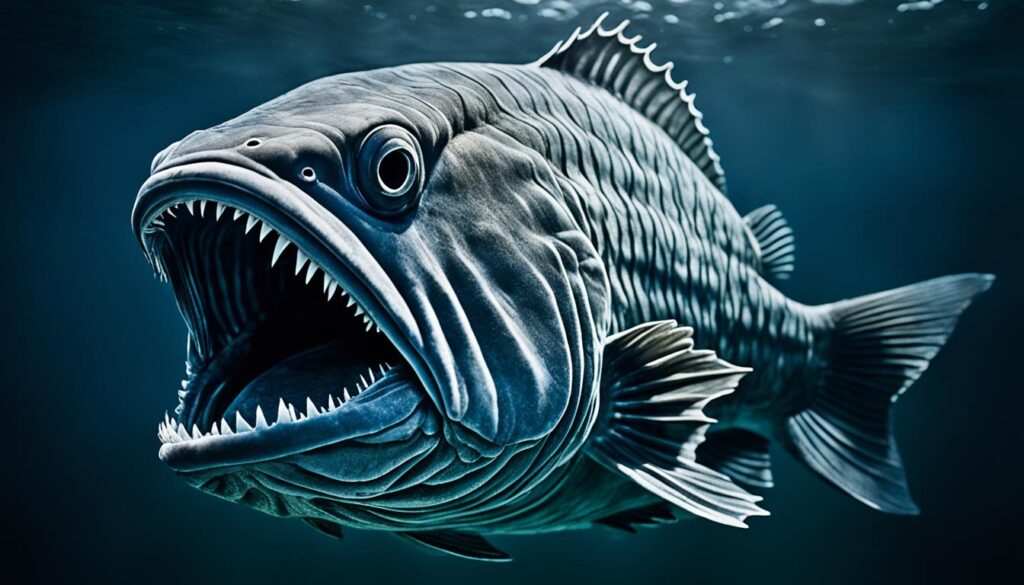
As we continue to learn more about the fascinating wolffish and its remarkable adaptations, let us also recognize the importance of preserving the delicate balance of our marine ecosystems. By nurturing and conserving these incredible creatures, we contribute to the safeguarding of our oceans’ biodiversity for generations to come.
Conclusion
Fish with big lips are not only fascinating marine creatures, but they also play a crucial role in maintaining ocean biodiversity. From the majestic humphead wrasse to the unique spotted handfish, these fish showcase the incredible diversity of life in our oceans. It is essential that we appreciate and protect these captivating species for future generations to enjoy.
The humphead wrasse, with its distinctive features and important role in coral reef ecosystems, highlights the intricate balance of marine life. Similarly, the spotted handfish, with its rare and endangered status, reminds us of the need for conservation efforts to preserve these remarkable creatures.
By acknowledging the value of fish with big lips and their contribution to ocean biodiversity, we can foster a greater understanding of the intricate web of life in our oceans. Through responsible fishing practices, habitat preservation, and raising awareness about the importance of marine conservation, we can ensure the continued existence of these mesmerizing marine species. Let us work together to protect and cherish these fascinating fish for generations to come.





